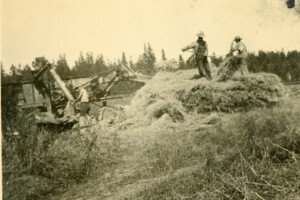Wheat and Flour
You might say that Salem’s flour mills had their beginning with the grist mills the first pioneers built throughout the first settlement in the 1840s. Jason Lee had a saw and grist mill on North Mill Creek at Liberty Street which ground enough wheat to feed the small community. Local farmers using a “grapevine” cradle cut a daily average of three acres of hard winter wheat which provided enough for their home, and a little to barter. A steam threshing engine of 15-horsepower, and a separator, improved production in 1870 to the point where there was a substantial surplus.
The Salem Flouring Mills Company was built in 1865 on the north bank of the millrace where it empties into the Willamette River just south of Trade Street. The mill was financed by owners of the Willamette Woolen Mill, which had been built a decade earlier in North Salem. The mill was sold in 1870 to the Kinney Brothers of San Francisco and, at the time, was described as the largest mill of its kind in Oregon and Salem’s leading industry; it could turn out 400 barrels of flour a day.
The wheat taken in was ground daily by paddle wheels and loaded on steamboats at the Ferry Street landing for shipment to Portland, San Francisco, and England. The mill was completely destroyed by fire on September 22, 1899, along with all the wheat.
A new mill was soon producing more than 400,000 bushels of flour annually, using only water power. The lumber for the new mill was provided by the Capital Lumbering Company adjoining it. In 1910, A. N. Bush bought the mill but, after it burned again in 1915, Bush sold the site and water rights to Oregon Pulp and Paper Company, whose owner also owned half of the Spaulding Lumber Company – an adjoining sawmill to the north.
Their flour brand, best-known and almost universally used locally, was the “Wild Rose” flour. They also marketed the “Salem” and “Pride of Oregon” brands commercially and, for the international markets, “Arcadia” for Liverpool; “Pagoda,” “Green Girl,” and “Eagle” for China and Japan; and “Salem Steamer” for British Columbia. A large business was done in cattle feeds and bran, brought in from other mills.
The Capitol Flouring Mills were built in 1877 further north where North Mill Creek empties into the Willamette River; the Willamette Valley Milling Company was built near them at the foot of Division Street in 1882. The latter burned October 7, 1904, in what was alleged to be an incendiary fire. At the time, a millrace ran southward along High Street to Division, and along it to the river.
The Capital City Mills, with Bryant and Pennell as proprietors, was supplying flour and mill feed from the SE corner of Church and Trade in 1902.
Other early mills included the South Salem Steam Flouring Mills owned by John H. Moores in 1874; and the Excelsior Mills in 1880. Cherry City Milling operated at 300 South Church in 1921 and at Trade & High in 1931; E. T. Barkus and Son were at 887 South Commercial; D.A. White and Sons were at 251 State in 1911; and Morris was at 2576 Fairgrounds Road in 1911.
Researched and written by Joan Marie “Toni” Meyering
Bibliography:
“Primitive Grist, Sawmill Salem’s First Industries”, Capital Journal, November 18, 1952.
“Ripples of Activity”, Statesman-Journal, September 16, 1994.
“The Salem Flouring Mills Company”, Oregon Statesman Daily, Illustrated Annual, 1903.
“Salem Flouring Mills Company to Rebuild its Plant”, Oregon Statesman, April 6, 1901.
“Salem Has Large Flouring Mills”, Oregon Statesman, January 1, 1910.
This article originally appeared on the original Salem Online History site and has not been updated since 2006.








Leave A Comment